
* Along with the fighter MiG-23s, a sequence of attack variants, culminating in the MiG-27 series, was built as well and proved successful. Since handling a variable-geometry aircraft was tricky, a two-seat conversion trainer, the "MiG-23UB", was also built in substantial numbers.
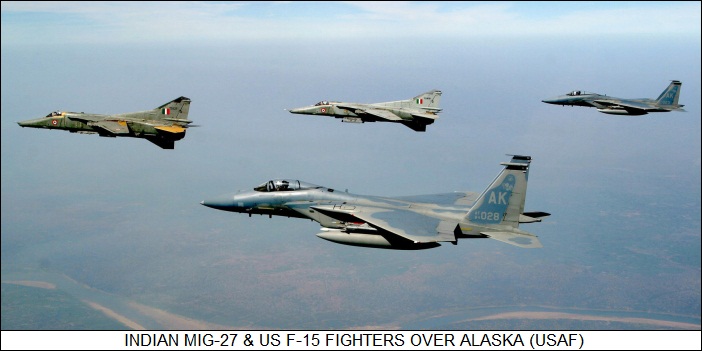
* The development of the MiG-23 fighter was paralleled by work on an attack aircraft based on much the same technology. In the 1960s, the primary attack aircraft of the VVS-FA were the Mikoyan MiG-17, built as an air-superiority fighter but shifted to the attack role later in its life, and the Sukhoi Su-7B, the USSR's first production purpose-built jet attack aircraft. The MiG-17 was old news by the late 1960s and the Su-7B had a number of limitations, such as poor warload and range, some saying the MiG-17 was a more effective strike aircraft.
A state requirement was issued for a new jet attack aircraft, with proposals from the Sukhoi and Mikoyan OKBs selected from a wide range of submissions. The Sukhoi effort emerged as the Su-17, essentially a much improved, VG version of the Su-7B, discussed elsewhere. The Mikoyan OKB had considered a number of different concepts for their submission, finally deciding that the fastest, cheapest, and most effective way to go was to develop an attack variant of the MiG-23 fighter, then in the works. The concept was designated "MiG-23Sh", where "Sh" stood for "shturmovik (storm bird)", the traditional Soviet name for an attack aircraft.
The fourth Aircraft 23-11 prototype was actually intended as a trials machine for the MiG-23Sh, carrying a hefty bombload on its four stores pylons. The trials with this prototype demonstrated clear inadequacies, but the exercise was useful since it revealed the need to improve pilot field of view, increase engine power, and provide more robust landing gear. A mockup of a more optimized aircraft was presented to VVS brass in late 1969, leading to approval of further development in early 1970. The aircraft finally emerged as the "MiG-23B" prototype, where "B" stood for "bombardirovshchik (bomber)", the first machine performing its initial flight on 18 February 1971, with Alexander Fedotov at the controls.
Externally, the MiG-23B was along the lines of an early-development MiG-23 fighter, with the early "Edition 1" wings but the set-back tailfin, mated to a new nose without radar and sloped down to give a good forward view. The new nose suggested that of the Anglo-French SEPECAT Jaguar attack aircraft, the MiG-23B's closest Western counterpart. The MiG-23B was fitted with a different engine, the Lyulka AL-21F-300, providing a dry thrust of 76.5 kN (7,800 kgp / 17,200 lbf) and an afterburning thrust of 110 kN (11,200 kgp / 24,700 lbf). The AL-21F was designed for the Sukhoi Su-24 attack aircraft and was said to have been based on the General Electric J79 turbojet, samples of that engine having been obtained from US F-4 Phantoms shot down over North Vietnam. A MiG-23 fighter prototype was fitted with an AL-21F as an engine demonstrator in 1970. Internal fuel capacity relative to the MiG-23S was increased by adding two more fuselage fuel tanks, giving a total internal fuel load of 5,750 liters (1,517 US gallons).
The cockpit featured armor glass and steel armor panels alongside the cockpit, plus heavy aluminum belly panels to protect the engine. The fuel tanks featured an inert gas system to prevent the fuel from catching fire if the tanks were hit. The general landing gear scheme of the MiG-23S was retained, but the assemblies were more robust to handle higher weights, and low-pressure tires were used to permit rough-field operation.
The MiG-23B featured a comprehensive Sokol-23S navigation-attack system, integrating a Fon laser rangefinder / marked target seeker (LRMTS) system in the nose; an ASP-17 reflector sight for level and dive attacks; a PBK-3 toss-bombing sight; the aircraft flight control system; and the aircraft navigation system, which incorporated a gyrocompass, Doppler radar, radar altimeter, radio direction finder, and radio navigation system receiver. The navigation system was linked to the autopilot to permit the aircraft to follow a simple preprogrammed flight path. The MiG-23B also featured a Siren-FSh ("Siren" translating as "lilac", incidentally) radio frequency (RF) jammer to deal with the fire-control radars of Western SAMs and anti-aircraft artillery (AAA), as well as a Sirena-10M RWR.
The GSh-23L twin-barreled cannon was retained, but an extra set of stores attachments were placed on the rear fuselage, each capable of mounting a rocket-assisted takeoff (RATO) unit or a bomb of up to 250 kilograms (550 pounds) weight. Total external load was up to 3,000 kilograms; a centerline tank was usually carried, with the stereotypical offensive stores arrangement being four 16-round or 32-round 57-millimeter rocket packs -- one on each wing glove pylon, and on each forward fuselage pylon. Heavier-caliber rockets were also possible stores: 20-round packs of 85-millimeter rockets, five-round packs of 122-millimeter rockets, or individual 240-millimeter rockets. There were a wide range of "dumb bomb" configurations.
Cannon pods, each with a GSh-23L cannon, could also be carried on the wing glove pylons. Pictures exist showing carriage of an R-13S / AA-2 Atoll AAM on each wing glove pylon, but a more typical defensive armament arrangement included four R-60 / AA-8 Aphid AAMs -- mounted with a dual stores rack on each wing glove pylon or on the forward fuselage pylons, but not on both the wing glove pylons and the forward fuselage pylons.
The MiG-23B could carry the Kh-23 (NATO AS-7 Kerry) ASM -- a primitive guided weapon, controlled by "eyeball" over a datalink, comparable to the US Bullpup ASM -- on the wing glove pylons. The Delta-N radio link antenna was fitted in a small pod on the leading edge of the right wing glove. The MiG-23B also had a nuclear strike capability, carrying a tactical nuclear store on a reinforced forward fuselage pylon.
The initial prototype of the MiG-23B didn't quite have all the pieces of the Sokol-23S nav-attack system. The second two prototypes did, and also featured the Edition 2 wing, with the dogtooth but no leading-edge flaps. Trials were complete in 1972, with the variant going into production at the Znamya Truda plant late in that year. Only about two dozen were built, about half serving as evaluation aircraft. NATO assigned this variant the reporting name of "Flogger-F".
* Since priority for the AL-21F-300 engine went to the Su-24 and the Su-17 strike fighter -- and it was expensive in any case -- Mikoyan engineers quickly obtained an alternative powerplant, the R-29B-300 afterburning turbojet, a variant of the Tumanskiy R-29-series specifically optimized by the Soyuz design bureau for the MiG-23 attack variant. Thrust ratings were 77 kN (7,850 kgp / 17,310 lbf) dry and 122 kN (10,600 kgp / 23,370 lbf) afterburning. Specific fuel consumption was higher than for the AL-21F-300, but the R-27F2M-300 was designed for the role, being optimized for low-level subsonic operation, with a noticeably short two-position exhaust nozzle. The engine was relatively cheap and easy to maintain, all the more so because of its similarity to R-29 engines used on MiG-23 fighter variants.
The new attack variant with the R-29B-300 engine was designated the "MiG-23BN"; since the short exhaust made it easy to distinguish from the MiG-23B, NATO assigned the MiG-23BN the new reporting name of "Flogger-H". It was otherwise very much like the MiG-23B, though it did feature a slightly improved Sokol-23N nav-attack system, as well as a rear-view mirror. The MiG-23BN went into production in 1973 at Znamya Truda. Early production suffered from some of the airframe weaknesses of early MiG-23 fighter production, but late production machines were generally robust -- a particularly important characteristic in a "mudfighter". In service, VVS pilots called the machine the "Utkonos (Duckbill)" or "Krokodil Gena (Crocodile Gena)", after a popular cartoon character.
About 624 MiG-23BNs were built into 1985, though only about a hundred served with the VVS-FA, with the rest exported. (One of the other reasons for abandoning the Al-21-series engine was that it was secret and couldn't be exported.) Warsaw Pact countries got an "A" subvariant, which was almost identical to VVS machines, even retaining nuclear strike capability; they were provided to Bulgaria, Czechoslovakia, and East Germany. Other users got a "B" version, missing countermeasures gear and with generally downgraded avionics; it was provided to Algeria, Cuba, Egypt, Ethiopia, India, Iraq, Libya, and Syria.
India was a particularly enthusiastic operator, with the Indian Air Force (IAF) obtaining 95 MiG-23BNs. A number were assigned to the defense-suppression role, carrying a variety of Soviet-built anti-radar missiles; some others were used in the tactical reconnaissance role, carrying the British-built Red Baron reconnaissance pod.
The Iraqis obtained 80 and fitted some of them with fixed, nose-mounted mid-air refueling probes -- like those on Iraqi Dassault Mirage F1 fighters, possibly using the same hardware -- for long-range strikes during the Iran-Iraq War of the 1980s. The Iraqis even fitted the French ATLIS laser targeting pod to their MiG-23BNs to guide the Kh-29L (NATO AS-14 "Kedge") laser-guided ASM.
BACK_TO_TOP* The reason the VVS only obtained a relatively small number of MiG-23BNs was because the service then quickly obtained a substantially more optimized derivative -- originally designated the "MiG-23BM" but introduced into service as the "MiG-27".
The MiG-27 retained the R-29B-300 engine of the MiG-23BN but deleted the variable engine intake ramps found on the MiG-23 fighters and the MiG-23B/BN. A less prominent "splitter plate", intended to prevent the ingestion of turbulent and stagnant "boundary layer" hugging the fuselage, replaced the old intake ramps. The new intake scheme limited performance to a maximum of Mach 1.7, but that wasn't regarded as much of an issue for a tactical attack aircraft, and the change helped reduce weight -- a total of 300 kilograms (660 pounds) was shaved off through that and other tricks -- and simplified maintenance. The landing gear was strengthened once again, as were the stores pylons, permitting a maximum external load of 4,000 kilograms (8,800 pounds).
The forward fuselage pylons were moved to under the engine intakes. Unguided rocket pods remained an important weapon. Dumb bomb configurations featured considerable variety:
The radio guidance system for the Kh-23 / AS-7 Kerry ASM was retained, though it was improved to the Delta-NM variant, which automated some of the guidance workload. A gun camera was fitted in a pod on the left wing glove, matching the pod for the Delta-NM on the other wing glove.
The GSh-23L two-barreled cannon was traded out for a six-barreled Gatling-type GSh-6-30 30-millimeter cannon, with a rate of fire of 5,000 rounds per minute, substantially greater than that of the GSh-23L, and an ammunition supply of 300 rounds crammed into the center fuselage. It was tilted off the centerline by 1.3 degrees, apparently to reduce nose pitch-up on firing.
The GSh-6-30 cannon had much greater killing power GSh-23L in principle; it was the Soviet answer to the US GAU-8 Avenger 30-millimeter Gatling of the Fairchild A-10 tank-buster aircraft. To no surprise, the GSh-6-30 had hefty recoil, and its integration with the MiG-27 proved troublesome -- in fact, it would always be somewhat troublesome. Incidentally, although the Gatling seems like a distinctly American weapon, the Soviets were perfectly familiar with it, since copies of the original 19th-century Gatling had been built in Tsarist Russia as the "Gorshov gun".
The avionics suite featured a new PRnK-23 nav-attack system, with digital instead of analog computing elements, providing much more precise targeting than the older Sokol-23S nav-attack system and greatly reducing pilot workload. Pilot data was provided on an ASP-17VG-1 HUD / gunsight. Other avionics remained the same, except for a six-round upward-firing chaff-flare dispenser installed in each wing glove.
Initial flight of the first MiG-27 was on 17 November 1972, with Valeriy Menitskiy at the controls. This machine was powered by an Al-21F-300 engine. Serial production began in late 1973 at state factory GAZ-124 in Irkutsk in Siberia. The MiG-27 went into VVS-FA service in 1975, to be given the NATO reporting name of "Flogger-D". 360 MiG-27s were built into 1977.
BACK_TO_TOP* The MiG-27 was followed in production by the "MiG-27K", initially known as the "MiG-27BK". It was essentially the same as the MiG-27 -- same general airframe, engine, Gatling cannon -- except for a substantially updated avionics suite:
The laser / camera targeting system permitted carriage of new laser-guided precision weapons -- the KAB-500L 500-kilogram (1,100-pound) laser guided bomb (LGB), as well as the Kh-25ML (NATO AS-10 Karen) and later Kh-29L (NATO AS-14 Kedge) laser-guided ASMs -- and electro-optic-guided precision weapons -- the KAB-500Kr electro-optic guided bomb (EOGB) and the Kh-29T / AS-14 Kedge electro-optic guided ASM. A Vyuga emitter targeting pod could be carried on the right forward fuselage pylon to permit targeting of the Kh-25MP (NATO AS-12 Kegler) anti-radar missile (ARM) and its improved Kh-27PS follow-on.
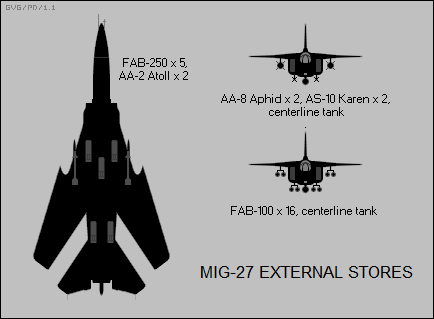
Other than the improved avionics, the MiG-27K looked much like the MiG-27, the only major external difference being a slightly more cluttered nose, with the pimple on top for the Siren jammer. In addition, while the MiG-27 had featured a pitot tube on the upper left side of the nose, in the MiG-27K the pitot tube was moved to the bottom left side of the nose, and an instrument landing system (ILS) antenna was fitted on the other side in parallel. The new avionics meant a substantial increase in aircraft weight, and so the scabbed-on armor alongside the cockpit was removed, the notion being that the increased use of stand-off weapons reduced the need for pilot protection. In the 1980s, combat in Afghanistan would suggest that notion was unrealistic, and the armor would be added back to MiG-27Ks serving in that theater. The Delta-NM and gun camera pods were deleted from the wing gloves; the old Kh-23 radio-guided ASM could still be carried using a pod carried on an underwing pylon.
* Initial flight of the MiG-27K prototype was on 30 December 1974, with Aviard Fastonetz at the controls. The avionics suite was sophisticated and development was protracted, with the type finally accepted into VVS service in 1980, with 197 built at the Irkutsk plant. An unarmed reconnaissance derivative, the "MiG-27R" -- with film cameras in the nose, infrared line scanner and electronic intelligence packages behind the cockpit, and the capability of carrying a side-looking airborne radar pod -- was proposed, but not built. The MiG-27K was assigned the NATO reporting name of "Flogger-J2", which leads to the question of what the "Flogger-J" was.
As it turned out, the Flogger-J was actually derived from the Flogger-J2. Concerns over the complexity of the MiG-27K led to the development of a simpler variant, the "MiG-27M", which would receive the Flogger-J reporting name. It retained much of the MiG-27K's gadgetry, including the Beryoza RWR and Siren jammer, but featured a cheaper and less sophisticated PrNK-23M nav-attack suite, built around the Klyon-PM laser designator and rangefinder.
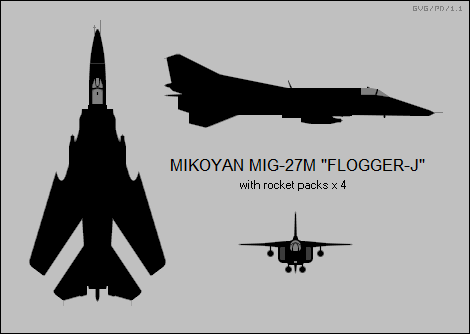
The MiG-27M could carry all the "smart" munitions carried by the MiG-27K except for the KAB-500L LGB. The MiG-27M was very hard to tell from a MiG-27K, except for the fact that the pitot tube and ILS antenna were moved from under the nose to the top. Initial flight of the first MiG-27M, a converted MiG-27, was in April 1976, and the type went into production in 1978 at a plant in Ulan Ude in Siberia. 162 Soviet-built MiG-27Ms were delivered into 1982.
___________________________________________________________________
MIKOYAN MIG-27M "FLOGGER-J":
___________________________________________________________________
wingspan (open):
13.97 meters (45 feet 10 inches)
wingspan (closed):
7.78 meters (25 feet 6 inches)
wing area (open):
37.27 sq_meters (401 sq_feet)
wing area (closed):
34.16 sq_meters (368 sq_feet)
length with probes:
17.14 meters (56 feet 3 inches)
height:
5 meters (16 feet 5 inches)
empty weight:
11,908 kilograms (26,257 pounds)
normal loaded weight:
18,100 kilograms (39,910 pounds)
MTO weight:
20,500 kilograms (45,200 pounds)
max speed at altitude:
1,885 KPH (1,170 MPH / 1,020 KT)
service ceiling:
15,600 meters (51,200 feet)
range (clean):
1,800 kilometers (1,120 MI / 975 NMI)
___________________________________________________________________
* That seems like a relatively small quantity, but from 1982 the decision was made to upgrade most of the MiG-27 fleet to MiG-27M standard. The upgrade was designated "MiG-27D" -- with "D" for "dorabotanniy (improved)" -- and about 300 conversions were performed into 1989. The MiG-27Ds were identical to the MiG-27Ms except for a slightly improved navigation system, but they were preferred to the MiG-27Ms because the factory at Irkutsk that built the MiG-27s had noticeably better production quality than the Ulan Ude plant.
* Although most export attack Floggers were MiG-23BNs, the MiG-27M was license-built by one user, the Indian Air Force (IAF). A deal for production at Hindustan Aeronautics Limited (HAL) was signed in the mid-1980s, with the first HAL machine, assembled from a knockdown kit supplied by the Irkutsk plant, performing its initial flight on 11 January 1986. A total of 165 HAL MiG-27Ms -- sometimes referred to with the designation of "MiG-27ML" -- were delivered into 1996, the first 50 being built from subassemblies provided by Irkutsk and the rest with increasing local content. They featured a downgraded avionics suite, with some IAF-specified kit. They were the last MiG-23/27s to be built.
BACK_TO_TOP* Although getting the fighter MiG-23s up to operational spec proved to be something of a trial, the attack MiG-23/27 appears to have matured fairly quickly. It was regarded as a sturdy and capable aircraft, with a very good availability rate and pleasantly low accident rate. In service, it was generally painted with disruptive camouflage topside and light blue-gray underneath.
Combat service of the MiG-27 with the VVS was very limited. The main "mudfighter" in the Afghan war was the Sukhoi Su-17, and nobody saw good reason to complicate logistics by introducing a different type. The MiG-27 was finally deployed to Afghanistan in 1988, with a single air regiment stocked with 36 MiG-27Ms and 4 MiG-23UB two-seaters sent to Shinand Air Base, as something of a combat evaluation program. The MiG-27Ms were generally used in high-altitude bombing attacks up to the withdrawal of Soviet forces in early 1989. The conclusion of the tour was that the MiG-27 was reliable and its cockpit armor very much an asset, but that it was overkill in terms of its ability to carry warload and its technical sophistication -- strike missions by all attack fighters in the theater rarely carried more than about 1,000 kilograms (2,200 pounds) of ordnance, and smart munitions were rarely needed or used. The Su-17 could handily do the job.
The MiG-27's GSh-6-30 cannon didn't prove particularly useful in practice. It was an impressive weapon in principle, with awesome hitting power and a thunderous sound described as more "felt" than "heard", but the recoil -- about 5.5 tonnes (6.05 tons) -- still had a tendency to inflict damage on the aircraft. The rate of fire was reduced to 4,000 rounds a minute, but that didn't help much. Landing lights almost always broke after firing, so on weapons training flights the lights were simply pulled out, and the sockets capped off; landings at night after such flights had to be made on floodlit runways. Firing more than about 30 rounds in a burst was asking for trouble from overheating and "cooking off" of rounds in the firing chamber. The weapon was a maintenance hog, in particular being prone to corrosion, presumably caused by hot gun gas. It seems that the GSh-30 twin-barreled 30-millimeter cannon, used on the Sukhoi Su-25 close-support aircraft, might have been a better fit.
Since the MiG-23BN was a popular export machine, it saw plenty of combat service in foreign air arms, fighting for the pro-Soviet Afghan, Libyan, Algerian, and Angolan governments -- with the Angolans initially using Cuban pilots and later mercenaries. The Iraqis were particularly enthusiastic users of the type, flying it in attacks against Kurdish insurgents during the 1970s and against the Iranians in the next decade. The Indian Air Force has used their attack Floggers in the fighting with separatists in the provinces of Jammu & Kashmir, with one lost in an accident. The IAF finally phased the MiG-23BN out in 2009.
Some MiG-27s were used for trials in the 1980s, for example one fitted with an arresting hook to investigate carrier landing system technology -- though it was used for ground tests only, snagging a cable after a fast taxi. There was an idea to develop a MiG-23 carrier fighter, but it didn't happen. Following the collapse of the Soviet Union, the VVS MiG-27 fleet was retired in the early 1990s as an economy measure, the service intending to standardize on the Sukhoi Su-24 and Su-25 for the attack role. Some have questioned the wisdom of this decision, claiming the MiG-27 was a highly cost-effective strike platform, but in any case the MiG-27s ended up being scrapped, or rotting away off the flight line.
A number of post-Soviet states inherited MiG-27s after the breakup of the USSR, with Kazakhstan using the type as a day fighter, armed with R-60M / AA-8 Aphid AAMs. Ukraine ended up with about 49 MiG-27s; they didn't fly in Ukrainian service, but seven were sold to Sri Lanka in 2000:2001, the sales package even including Ukrainian pilots to fly them. The MiG-27s were promptly put into service fighting Tamil Tiger insurgents. One MiG-27 was destroyed in a ground attack in 2001, with two others lost in accidents.
Attack Floggers were evaluated by Western air forces. The US bought a set of MiG-23BNs from Egypt in the early 1980s and used them for flight evaluation and in "dissimilar air combat training (DACT)". A Cuban pilot defected to Florida in a MiG-23BN in 1991; the fate of this aircraft is unclear.
* In the aftermath of the fall of the Soviet Union, in the late 1990s the Mikoyan organization promoted a package of upgrades for export MiG-23BNs or other attack Floggers, featuring improved engines, new avionics, improved cockpit, and compatibility with the latest weapons. Nobody seemed interested. However, in 1999 the IAF initiated an upgrade program for their relatively youthful MiG-27Ms, with the upgrade performed by HAL in collaboration with the Defence Avionics Research Establishment (DARE) in Bangalore. The initial contract specified the upgrade of 40 machines, with as many as 135 to be updated eventually.
The upgrade featured a "service life extension program (SLEP)" to keep the airframe in flightworthy condition to 2020. Most of the work focused on improved avionics, including;
Improved engines were considered, but not incorporated into the upgrade. The improved MiG-27M is compatible with a wide range of the latest Western smart munitions, as well as the Vinten VICON 18 reconnaissance pod. Initial flight was on 25 March 2004, with Group Captain Ashit Mehta at the controls. Initial redelivery to the IAF was in 2006, with upgrades of the batch of 40 completed by the beginning of 2009. It only extended the type's life with the IAF by a decade, the last Indian MiG-27s being retired in 2019. IAF pilots were, it seems, not unhappy to see it go, the type having a high accident rate and a reputation for unreliability.
BACK_TO_TOP* At the outset of the MiG-23 program, the need was recognized for a two-seat dual-control machine to train pilots in the art of flying a VG fighter. Development of the two-seater was authorized in late 1967, with the first "MiG-23U" performing its initial flight on 10 April 1970, with Mikhail Komarov at the controls.
The prototype was essentially a tandem-seat MiG-23S, with the trainee in the front cockpit and the flight instructor in the rear. Both had their own rear-hinged clamshell canopies. The rear canopy had a folding periscope to give the flight instructor a good view forward during takeoffs and landings; the periscope popped out when the landing gear was extended and folded flat again when the landing gear was retracted. It was a trick the MiG OKB had invented for the MiG-21UB trainer, and possibly leveraged off the same periscope hardware. The back-seater also had a control panel to allow him to simulate various flight emergencies for the trainee, which no doubt provided considerable amusement to the instructors and substantial frustration for the trainees.
Internal systems were rearranged to accommodate the second seat and some avionics were moved forward of the cockpit, resulting in a longer nose. The trainer was supposed to be combat-capable, not only featuring the GSh-23 cannon but even the Sapfir-21 radar.
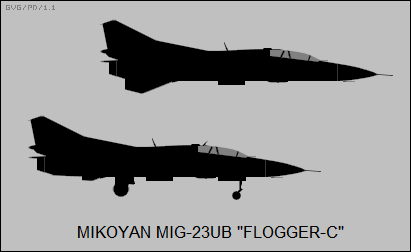
Production began in 1970 at the plant in Irkutsk, with the production machine designated the "MiG-23UB". (MiG-27s built at the Irkutsk plant were painted with a fake rear canopy before rollout to trick US satellite intelligence into believing the Irkutsk plant only made MiG-23UBs.) The MiG-23UB was quickly updated in 1971 with the "Edition 3" dogtooth wing with leading-edge flaps and the ability to carry ferry tanks. Some early production machines had the Sapfir-21 radar, but most were built with ballast in place of the radar, the radar having proven more bother than it was worth in practice. Most or all production had the R-27F2-300 engine. Late production had improved flight-control systems, which were retrofitted to some early production.
___________________________________________________________________
MIKOYAN MIG-23UB "FLOGGER-C":
___________________________________________________________________
wingspan (open):
13.97 meters (45 feet 10 inches)
wingspan (closed):
7.78 meters (25 feet 6 inches)
wing area (open):
37.27 sq_meters (401 sq_feet)
wing area (closed):
34.16 sq_meters (368 sq_feet)
length with probe:
16.42 meters (53 feet 10 inches)
height:
4.82 meters (15 feet 10 inches)
empty weight:
10,920 kilograms (24,080 pounds)
normal loaded weight:
15,080 kilograms (33,250 pounds)
MTO weight:
18,000 kilograms (39,690 pounds)
max speed at altitude:
2,500 KPH (1,550 MPH / 1,350 KT)
service ceiling:
15,800 meters (51,840 feet)
range (clean):
1,210 kilometers (750 MI / 655 NMI)
___________________________________________________________________
NATO assigned the MiG-23UB the reporting name "Flogger-C". Soviet crews called it a "Sparka (Twin)", a general term for a two-seat trainer. Production of the MiG-23UB for Soviet forces ended in 1978, but export production continued to 1985. Factory records claim 769 were built, with roughly three-quarters delivered to Soviet forces and the rest provided to the various foreign air arms operating the MiG-23. Color schemes generally followed those of the MiG-23 units the Sparkas were associated with.
MiG-23UBs were used in several cases as test and trials aircraft. A number of MiG-23UBs were upgraded in the 1980s to "MiG-23UM" standard with improved avionics to reflect the configuration of contemporary MiG-23 fighters. Plans were floated after the fall of the USSR for further upgrades, but little came of them.
BACK_TO_TOP* The following list summarizes MiG-23/27 variants:
* The MiG-23 seems to be less prominent than the other MiG fighters, and after doping it out I begin to suspect why. It would be an exaggeration to say that the MiG-23 fighter was a bad aircraft, but it did take a lot of effort to bring it to maturity. It seemed to do well enough in the interceptor role. The MiG-27 attack Flogger appears to have been much more satisfactory, likely because the attack role didn't place such demands on agility.
As with many Soviet types, the old data on the MiG-23/27 found in the West is dubious in many ways. However, Yefim Gordon's book on the type included a picture of a MiG-23BN at a museum with a stores loadout that defied simple logic -- fitted with unguided rocket pods in tandem on dual stores racks on the wing glove pylons -- a configuration that unsurprisingly drew sarcastic comments from Gordon. I suppose that might have made sense for a armed ferry flight, but I doubt it was done in practice.
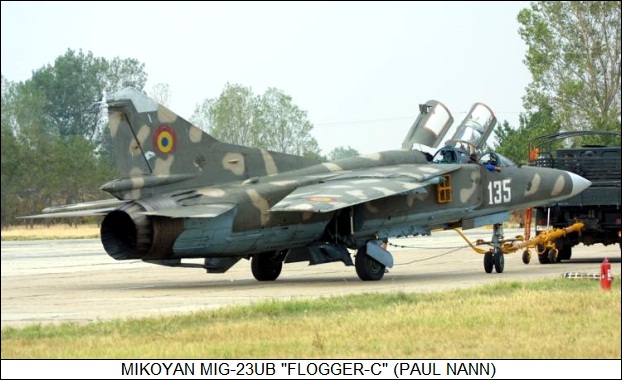
* Sources include:
* Revision history:
v1.0.0 / 01 mar 07 v1.0.1 / 01 apr 07 / Follow-up polish release. v1.0.2 / 01 apr 09 / Review & polish. v1.0.3 / 01 mar 11 / Review & polish. v1.0.4 / 01 feb 13 / Review & polish. v1.0.5 / 01 jan 15 / Review & polish. v1.0.6 / 01 dec 16 / Review & polish. v1.0.7 / 01 nov 18 / Review & polish. v1.0.8 / 01 sep 20 / Review & polish. v1.0.9 / 01 jul 22 / Review & polish. v1.0.9 / 01 jul 22 / Review & polish. v1.1.0 / 01 jun 24 / Review & polish. (++)BACK_TO_TOP
